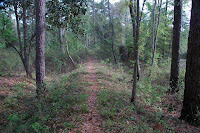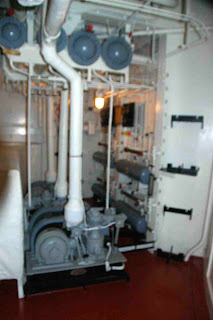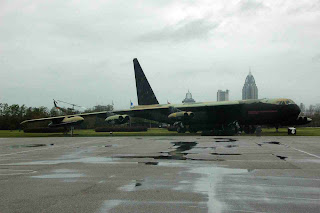After driving to the Mobile area not knowing where I would stay, as I said in day 5, I looked up state parks in the area, and found Blakeley State Park. I don't know that I've ever heard of Blakeley before, but it is of some historic interest.
Blakeley was once a thriving township. During this point, it was actually a bigger, wealthier town than Mobile. Almost all traces of the township have vanished, but what does remain is a real rarity. Blakeley was the site of one of the last battles in the Civil War - it was actually faught after the Civil War officially ended. Because the township had dissolved, and because it is relatively remote for people from other areas that continued to develop after the war, it was left untouched for a while after the war.
Not until some men looking to sell some of the old growth yellow pine came across it did people take note of it, and almost all the earthworks remain in tact. Even those trees are mostly still there. When the company that harvested them got to the mill, there was so much lead embedded in the trunks that they couldn't be cut, so the balance of the old growth forest is one of the most preserved habitats for these large, straight grained, trees, which were almost completely wiped out because of their value for lumber.
To start the day, I strolled through the cemetary near the campgrounds, which has some markers much more recent than the death of the town of Blakeley, and a number of them from it's time as well.
The campgrounds are a hike from the battlefield, which is also accessible by car, as a road has been cut into it. I decided to hike it, since there is a historic trail that connects them.
 The historic trail looked almost like it hasn't been traversed since the Civial War. Grossly overgrown and in places where there are boardwalks, they are so dilapidated that at one point, I jumped off, into the muck, because they were completely unusable. Of course, there was a warning not to take that part of the trail, but who really heeds those sorts of warnings? Besides, I'd already done half of the trail, so there was no going back.
The historic trail looked almost like it hasn't been traversed since the Civial War. Grossly overgrown and in places where there are boardwalks, they are so dilapidated that at one point, I jumped off, into the muck, because they were completely unusable. Of course, there was a warning not to take that part of the trail, but who really heeds those sorts of warnings? Besides, I'd already done half of the trail, so there was no going back. Unfortunately, just before reaching this point, my SLR batteries died, and as had happened before, though I had my day pack strapped to my back, which would have made it easy to carry my point-and-shoot, I had left it in the car. Again, at this point, I was not going back for it, so I carried my SLR the rest of the way on the trail, which seemed to get more rugged the further I went.
 I finally emerged on the side of the Confederate redoubt, and noticed a group of about 30 a ways off, gazing around he battlefield with binoculars and cameras. I knew these people weren't as interested in the battlefield as they were in it's birds. Surveying the still smoking field, I saw that the ranger had been wrong about them not burning the fields due to the winds (they occasionally do a controlled burn to control the grass growth on the fields). I made my way along the breastworks to the other side, where the road into the battlefield is located, and where the map's tour numbering can start to be seen.
I finally emerged on the side of the Confederate redoubt, and noticed a group of about 30 a ways off, gazing around he battlefield with binoculars and cameras. I knew these people weren't as interested in the battlefield as they were in it's birds. Surveying the still smoking field, I saw that the ranger had been wrong about them not burning the fields due to the winds (they occasionally do a controlled burn to control the grass growth on the fields). I made my way along the breastworks to the other side, where the road into the battlefield is located, and where the map's tour numbering can start to be seen. The bird people had gotten back in their vehicles, and were proceeding through the battlefield by the time I got to the spot they were at. I followed them on foot, taking note of the marker numbers along the road as it wove through the battlefield. There are rifle pits and mine pits (they look mostly the same, but the mine pits were originally filled with black powder, whereas the rifle pits were filled with riflemen).
The bird people had gotten back in their vehicles, and were proceeding through the battlefield by the time I got to the spot they were at. I followed them on foot, taking note of the marker numbers along the road as it wove through the battlefield. There are rifle pits and mine pits (they look mostly the same, but the mine pits were originally filled with black powder, whereas the rifle pits were filled with riflemen). There are trenches, natural fortifications and earthworks, redoubts, breastworks, and artillery batteries. Mostly, it looks like a field of rolling hills, but as you walk or drive through it, you can clearly see the indications of the harrowing battle and the rough terrain on which 216 men lost their lives, and another 955 were wounded. Due to it's remoteness, this is one of the best preserved battlefields left from the Civil War, with only minor repairs to the breastworks and the occasional burning to keep the grass in check.
I caught up to the bird people at the union battery, where they had a guide that was telling them about the battlefield and some of it's history, including the accounting of the trees that were rejected by the saw mill.
After tagging along for some of the discussion, I explored some more, including a zig-zag trench the Union troops started digging toward the Confederate lines, and they got in their vehicles and drove off, while I started walking the road back to the campgrounds.
When I got back to the campgrounds, I unstrapped my backpack, grabbed my backup camera, and trekked back to the battlefield. No I didn't! I drove back to the battlefield. No need to rewalk the whole thing! Driving through gave a nice perspective, until I stopped on my way out of the area to get one last picture.
After taking the picture (whch isn't worth posting), I went back to my car, the keys still in the ignition. The door wouldn't budge to let me back in. How did it get locked? I didn't know, but fortunately, I had the windows open. I reached in and hit the door locks. No change. I noticed the door lock indicated it wasn't locked, so I tried locking it, then unlocking it again, to no avail. Finally, I just tugged on the (unlocked) door harder, and it finally gave way, but so did the door panel. Apparently, the panel had somehow gotten loose, and had wedged the door closed. Now I had to repair my car in the field - literally.
I got in, and gingerly closed the door. I was in the middle of the road, and though it's not a high traffic road, it's hardly the right place for repairing a car. I pulled off the road at the next opportunity, found a nice spot, and parked. Then I opened the door. The door panel was bulging in the middle, so I tried to push it back into place, but it wasn't having it. I knew I'd have to remove it completely and reseat it.
I tugged aroung the edge of the panel to remove the clips that hold the edge. Unfortunately, this still wasn't enough for me to reseat it, so I had to remove some screws in the armrest. Fortunately, though I didn't bring my toolset with me due to space restrictions, I did have my Bucktool. Using it I was able to remove the 4 screws that hold the panel on...but there's five. The last one is recessed so far into the bottom of the arm rest that the Bucktool just couldn't get to it. Then I remembered I had brought my Leatherman with me as well, thanks to my brother's suggestion, and my reasoning that it can come in handy to have two pairs of pliers. It's philips screwdriver just barely reached, so I was able to get the last screw out and remount the panel.
Now that that crisis was averted, I finished exploring the park - heading to the site of the old town, where a gazebo now stands near the "Hanging Tree," which served a name fitting purpose during the town's existence.
I also drove down to the waterfront, and walked the wobbly boardwalk, taking note of the orchids and a reptile who was hanging out there.
 Nea the waterfront, I explored the "Hiding Tree," a large oak tree with a hollow in it's trunk large enough to fit a couple of men, which was used by Confederates trying to hide out from Union patrols.
Nea the waterfront, I explored the "Hiding Tree," a large oak tree with a hollow in it's trunk large enough to fit a couple of men, which was used by Confederates trying to hide out from Union patrols.USS Alabama State Park
With the park fully explored, it was time for me to move on, so I struck camp and set course for Mobile. Specifically, I headed for the USS Alabama State Park, a museum keystoned by it's namesake - the retired battleship USS Alabama. Other attractions include numerous tanks and aircraft, and a retired submarine, USS Drum, which are positioned outside the gates for easy access.
Because I left Blakeley State Park later than I expected, I arrived at the USS Alabama park about 2 hours before it closes. I started out by checking out some of the tanks and getting various angles of the battleship.
 There was a pelican at the end of the dock I used to get some different angles of the battleship, so I shot him, too, then purchased my ticket, and went to explore the battleship.
There was a pelican at the end of the dock I used to get some different angles of the battleship, so I shot him, too, then purchased my ticket, and went to explore the battleship.There are 3 self guided tour routes on the battleship. One takes you along the lower decks in the stern, one is the forward part (bow end) of the lower decks, and the other covers the upper decks and control tower.
I started out with the stern, which includes crew living quarters, galley, bakery, brig, barber shop, and laundry.



Next, I completed the lower decks of the boat in the forward part of the ship, which includes Warrant's Officer's living quarters, Marine Corps living quarters, post office, sick bay, engine room, and radio room.


Finally, I started on the upper deck tour. This tour encompasses the main and upper decks, including officer's living quarters, main guns, anti-aircraft guns, ship's bridge, flag pilot room, and the fire control tower. Unfortunately, while I was doing the other tours, the weather turned stormy, making me hurry through much of the upper deck tour, though it also cleared out some of the riff-raff that would otherwise have been in my way.
When I finished the battleship, I still had about 30 minutes left before closing. I briefly considered going oer to the submarine, but figured I wouldn't have enough time to do it justice, and the battleship was at times difficult enough to move about in, and it's far more accomodating than any submarine.
Instead of starting the USS Drum, I explored the airplane hanger that stands between the sub and the battleship. In the hanger are several very interesting military aircraft, many of which I had recently seen at the NAS National Aviation Museum, and here, they thought it would be beneficial to have mannequins dressed up as the pilots of these aircraft.
After looking at a tomcat (F14 - think "Top Gun"), I turned and saw something I didn't really think they had. Something pictured on their website and brochure, but something so ellusive and formerly so secretive that it seemed unfathomable they would display it for visitors. A plane that inspired me as a child. I built a rocket in it's shape. I custom assembled a lego aircraft inspired by it's design. A plane that still holds the record for the fastest air-engine craft ever built - a plane whose defense against a missile attack was not to disarm the missile, but to fly faster and higher than any missile could go. A plane that was the forerunner to the modern stealth aircraft. Yes, none other than the SR-71 Blackbird!
This plane is massive and ugly. It looks much like the paper covered rocket that I made as a kid. It's wings edges ripple in wierd places, so as it acheives speeds in excess of Mach 3, they will deform into the proper shape to make it's flight more stable. It's simple diamond based cross section and smooth surfaces create a lean, slender form, with it's skin that clings to it's fuselage and it's dual, wing mounted engines like a bat's wing. While it is one of the largest non-cargo military planes I have ever seen, it is a plane whose reputation for it's remarkable capabilities surpasses it's plain appearance.
I stood awestruck, as people that obviously didn't understand what an engineering marvel it is walked on by as if it was just another thing in their way to get to the submarine. I didn't care. It was amazing!
The park was closing, so I headed out to the parking lot, where I checked out the craft that was n display outside before leaving.
Mobile
 With the park closing, I figured I would check out some of Mobile. I headed to the cathedral of the Immaculate Conception. Though it's visiting hours are during the morning and early afternoon, it was open, so I went in to take a look.
With the park closing, I figured I would check out some of Mobile. I headed to the cathedral of the Immaculate Conception. Though it's visiting hours are during the morning and early afternoon, it was open, so I went in to take a look. I also drove by the Oakleigh Historic Complex, a complex of 3 historic buildings from different periods located in Mobile. It was also closed for the day, so I considered going back the next day, when I noticed a rattle in what I thought was the suspension of the car. Unfortunately, travelling in my car with limited space meant that I couldn't take my tools with me, so I had no choice but to take my car into a shop. I decided I should stop driving until I could take my car in to be checked out in the morning.
There weren't any camp sites available in Mobile, so I checked myself into a La Quinta for the night.



















































































































No comments:
Post a Comment